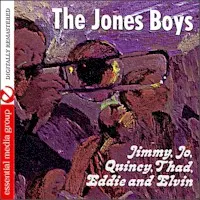Time: 37:52
Size: 86.7 MB
Styles: Crossover jazz
Year: 1968/2009
Art: Front
[2:51] 1. Baby Elephant Walk
[3:14] 2. Charade
[3:48] 3. Dreamsville
[4:09] 4. Bird Brain
[2:42] 5. Days Of Wine And Roses
[2:28] 6. Mr. Lucky
[3:26] 7. The Pink Panther
[2:50] 8. (I Love You) And Don't You Forget It
[3:08] 9. Soldier In The Rain
[3:45] 10. Odd Ball
[2:31] 11. Moon River
[2:54] 12. Peter Gunn
As modern big-band leaders go, Quincy Jones in the '60s would be first choice for many composers who wrote for a television series or the cinema. Though not the original themes, Jones was quite able to produce a full album featuring Henry Mancini's famous songs from movies and the small screen. This collection of the familiar and obscure Mancini done in 1964, preceded famed epic scores written by Jones from films The Pawnbroker and The Deadly Affair. It comprises several well-known hit tunes and a smattering of cuts not easily identifiable as the hummable and memorable Mancini classics. Taken from three separate sessions, the bands assembled by Jones are loaded, including Jerome Richardson, Billy Byers, Urbie Green, Clark Terry, Ernie Royal, Snooky Young, Mundell Lowe, Zoot Sims, Phil Woods, and Seldon Powell, Drummer Osie Johnson plays on all tracks, pianist Bobby Scott is a central figure, as are bassists Milt Hinton and Major Holley. A young saxophonist and flutist named Roland Kirk appears on four tracks, and the emerging vibraphonist Gary Burton is on another eight. A burgeoning talent, Jones was 31 when these recordings were made, and gaining momentum for his talents in Hollywood and Los Angeles. Though everybody knows "Baby Elephant Walk," they might not have heard the thorny electric guitar, staccato bells, and bowed bass and vocals via Holley and Hinton that Jones inserts into this version. Where the cool and slinky theme from "Pink Panther" also has the bassists jiving vocally and using their arco techniques under flutes and finger snaps, "Mr. Lucky" is the epitome of Count Basie like cool, while the spy music of "Peter Gunn" retains the bassists trickery as Burton's electrically echoed marimba and a Phil Woods alto sax solo broaden the scope of "Peter Gunn"'s field.
"Dreamsville" is a luscious ballad with harp and piano featured, "Days of Wine & Roses" starts typically pristine but runs into detailed, progressive interpretations, and "Moon River" is completely changed up into a waltz with Kirk's irresistible small saxello solo. The very hip, easy swinging "Odd Ball" is certainly the least-known Mancini piece not related to any cinematic connection, as quickened horns contrast against the slower beat and the choppy chords of Scott. The obscure "Charade" is really a jewel of the brilliance in re-arrangement Jones proffers, and perfectly deserving of its title. As slowed 3/4 in quicker 6/8 time signatures surface via an obtuse ostinato bassline, the horns accent fully juxtaposing lines swinging amongst a bit of psychedelia. A cute waltz is "Bird Brain," bouncy and fun with the flutes ricocheting off the walls, while "And Don't You Forget It" is a cowboy samba appropriate for any spaghetti western. Harmonicist Toots Thielemans is featured on one track, the ballad "Soldier in the Rain," with the sighing horns as the precipitation. How Jones is able to interpret Mancini's music with such diversity and new ideas is positively amazing, providing a unique listening experience for even the staunchest Q fan. ~Michael G. nastos
"Dreamsville" is a luscious ballad with harp and piano featured, "Days of Wine & Roses" starts typically pristine but runs into detailed, progressive interpretations, and "Moon River" is completely changed up into a waltz with Kirk's irresistible small saxello solo. The very hip, easy swinging "Odd Ball" is certainly the least-known Mancini piece not related to any cinematic connection, as quickened horns contrast against the slower beat and the choppy chords of Scott. The obscure "Charade" is really a jewel of the brilliance in re-arrangement Jones proffers, and perfectly deserving of its title. As slowed 3/4 in quicker 6/8 time signatures surface via an obtuse ostinato bassline, the horns accent fully juxtaposing lines swinging amongst a bit of psychedelia. A cute waltz is "Bird Brain," bouncy and fun with the flutes ricocheting off the walls, while "And Don't You Forget It" is a cowboy samba appropriate for any spaghetti western. Harmonicist Toots Thielemans is featured on one track, the ballad "Soldier in the Rain," with the sighing horns as the precipitation. How Jones is able to interpret Mancini's music with such diversity and new ideas is positively amazing, providing a unique listening experience for even the staunchest Q fan. ~Michael G. nastos
Explores The Music Of Henry Mancini




















